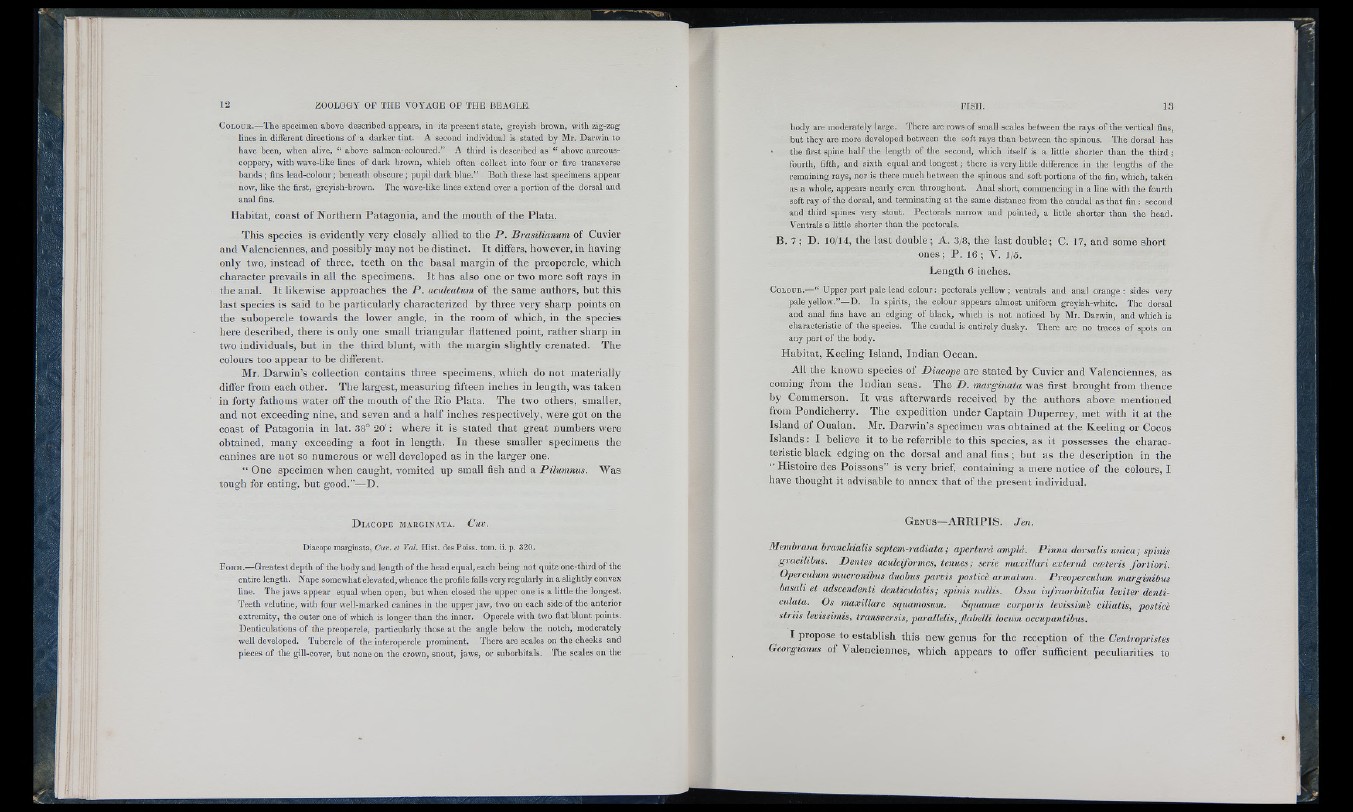
C o l o u r .—The specimen above described appears, in its present state, greyish brown, with zig-zag
lines in different directions of a darker tint. A second individual is stated by Mr. Darwin to
have been, when alive, above salmon-coloured.” A third is described as “ above aureous-
coppery, with wave-like lines of dark brown, which often collect into four or five transverse
bands ; fins lead-colour; beneath obscure; pupil dark blue.” Both these last specimens appear
now, like the first, greyish-brown. The wave-like lines extend over a portion of the dorsal and
anal fins.
Habitat, coast of Northern Patagonia, and the mouth of the Plata.
This species is evidently very closely allied to the P . Brasilianum of Cuvier
and Valenciennes, and possibly may not be distinct. It differs, however, in having
only two, instead of three, teeth on the basal margin of the preopercle, which
character prevails in all the specimens. It has also one or two more soft rays in
the anal. It likewise approaches the P . aculeatum of the same authors, but this
last species is said to he particularly characterized by three very sharp points on
the subopercle towards the lower angle, in the room of which, in the species
here described, there is only one small triangular flattened point, rather sharp in
two individuals, hut in the third blunt, with the margin slightly crenated. The
colours too appear to be different.
Mr. Darwdn’s collection contains three specimens, which do not materially
differ from each other. The largest, measuring fifteen inches in length, w’as taken
in forty fathoms water off the mouth of the Rio Plata. The two others, smaller,
and not exceeding nine, and seven and a half inches respectively, were got on the
coast of Patagonia in lat. 20': where it is stated that great numbers were
obtained, many exceeding a foot in length. In these smaller specimens the
canines are not so numerous or -well developed as in the larger one.
“ One specimen when caught, vomited up small fish and a Pilumnus. Was
tough for eating, hut good.”—D.
D i a c o p e m a r g i n a t a . C u v .
U iacope m arginata, C uv. et Val. H ist, des Poiss. tom . ii. p . 320.
F o rm .— Greatest depth of the body and length of the head equal, each being not quite one-third of the
entire length. Nape somewhat elevated, whence the profile falls very regularly in a slightly convex
line. The jaw s appear equal when open, but when closed the upper one is a little the longest.
Teeth velutine, with four well-marked canines in the upper jaw , two on each side of the anterior
extremity, the outer one of which is longer than the inner. Opercle with two flat blunt points.
Denticulations of the preopercle, particularly those at the angle below the notch, moderately
well developed. Tubercle of the interoperele prominent. There are scales on the cheeks and
pieces o f the gill-cover, but none on the crown, snout, jaw s, or suborbitals. The scales on the
body are moderately large. There are rows of small scales between the rays o f the vertical fins,
but they are more developed between the soft rays than between the spinous. The dorsal has
the first spine half the length of the second, which itself is a little shorter than the th ird ;
fourth, fifth, and sixth equal and longest ; there is very little difference in the lengths of the
remaining rays, nor is there much between the spinous and soft portions of the fin, which, taken
as a whole, appears nearly even throughout. Anal short, commencing in a line with the fourth
soft ray of the dorsal, and terminating at the same distance from the caudal as th a t fin : second
and third spines very stout. Pectorals narrow and pointed, a little shorter than the head.
Ventrals a little shorter than the pectorals.
B. 7; D. 10/14, the last double; A. 3/8, the last double; C. 17, and some short
ones; P. 16; V. J/5.
Length 6 inches.
C o l o u r .— “ Upper part pale lead colour: pectorals yellow ; ventrals and anal orange : sides very
pale yellow.”— D. In spirits, the colour appears almost uniform greyish-white. The dorsal
and anal fins have an edging of black, which is not noticed by Mr. Darwin, and which is
characteristic of the species. The caudal is entirely dusky. There are iro traces of spots on
any p art of the body.
Habitat, Keeling Island, Indian Ocean.
AH the known species of Piacope are stated by Cuvier and Valenciennes, as
coming from the Indian seas. The P . marginata was first brought from thence
by Commerson. It was afterwards received by the authors above mentioned
from Pondicherry. The expedition under Captain Duperrey, met with it at the
Island of Oualan. Mr. Darw in’s specimen was obtained at the Keeling or Cocos
Islands : I believe it to he referrible to this species, as it possesses the characteristic
black edging on the dorsal and anal fins ; hut as the description in the
“ Histoire des Poissons” is very brief, containing a mere notice of the colours, I
have thought it advisable to annex that of the present individual.
G en u s-A R R IP IS . Jen.
Membrana hranchialis septem-radiata ; aperturd ampia. Pinna dorsalis unica; spinis
gracilibus. Pentes aculeiformcs, tenues; serie ma.xillari externd cesteris fortiori.
Operculum mucronibus dxiobus parvis posticè armatum. Preoperculum marginibus
basali et adscendenti denticulatis ; spinis nullis. Ossa infraorhitalia leviter denti-
culata. Os maxillare squamosum. Squamce corporis levissimh ciliatis, posticè
striis levissimis, Iransversis, qmralleUs, jlabelli locum occupantibus.
I propose to establish this new genus for the reception of the Centropristes
Georgianus of Valenciennes, which appears to ofier sufficient peculiarities to